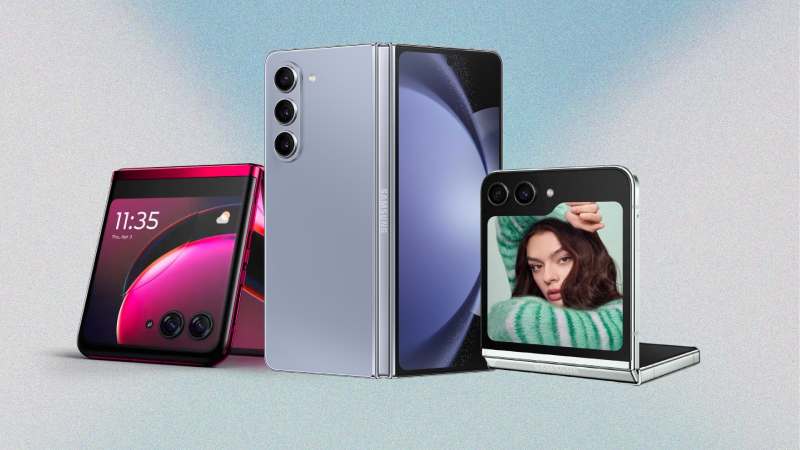The global smartphone market is experiencing a slowdown in growth, with some analysts even calling it a recession. However, within this context, one segment is bucking the trend. It’s a foldable smartphone. These innovative devices, with their unique ability to scale to larger screens, are experiencing significant growth and offer a glimpse into the future of mobile technology.
According to a recent study by Display Supply Chain, sales of foldable smartphones in the fourth quarter of 2023 reached a total of 4.2 million units, a significant 33% increase compared to the same period in 2022. This upward trend is expected to continue. Analysts are predicting a staggering 105% year-over-year increase in sales for the first quarter of 2024.
Huawei’s Rise in the Clamshell Market
One of the most interesting developments in the folding device market is a possible change in leadership in clamshell-style folding devices. Traditionally, this market has been dominated by Samsung’s Galaxy Z Flip series, but there could be a power struggle. Counterpoint Research believes that Huawei, a major player in the smartphone industry, could overtake Samsung in terms of market share. This change hinges on the success of Huawei’s upcoming Pocket 2 model. Early signs are positive. Huawei will reportedly increase its purchase of foldable display panels from BOE in the fourth quarter of 2023, suggesting high volume expectations for the Pocket 2.
A Diversifying Landscape: Brand Distribution and Top Performers
The foldable smartphone market is no longer a one-on-one competition. Samsung remains the dominant player, with four of its 10 best-selling models belonging to the Galaxy Z series (Z Flip 5 and Z Fold 5), but other brands are also making their mark. Honor and OPPO each boast two of his models within the top 10, with Honor Magic Vs 2 and OPPO Find N3 Flip demonstrating the growing capabilities of both companies in the foldable field. Established players like Xiaomi and emerging players like ZTE (with Nubia Flip/Libero Flip) are also contributing to the diversification of this segment. Currently, the Samsung Galaxy Z Flip 5 is on top, closely followed by the Huawei Mate X5 and Honor Magic Vs 2.
Innovation Pipeline: A Week of New Foldable Devices
The foldable device market is poised for further expansion due to increased consumer interest. According to supply chain data analyzed by Counterpoint Research, the number of new foldable smartphones scheduled to be launched by the end of 2024 is a staggering 27. Three models have already been unveiled: the aforementioned Huawei Pocket 2, Honor Magic V2 RSR, and ZTE Nubia Flip/Libero Flip, whetting the appetite of technology enthusiasts. The influx of new devices from various brands highlights manufacturers’ commitment to this evolving technology.
The Future of Foldable Devices: A Catalyst for Market Growth
The success of foldable smartphones is a testament to consumer demand for innovative and immersive mobile experiences. The ability to transform from a compact phone to a large tablet-like device meets the growing desire to multitask on the go. This trend, coupled with the continued development of foldable display technology and reduction in production costs, is expected to further propel the sector in the coming years. Analysts predict that global shipments of foldable smartphones could exceed 100 million units by 2027.
The rise of foldable devices also presents unique opportunities for app developers and content creators. As screen sizes increase and user interactions become more nuanced, new opportunities arise for app design and interface optimization. This further improves the user experience and accelerates market adoption.
However, some challenges remain. Compared to traditional smartphones, foldable smartphones are currently expensive. Additionally, there are still concerns about durability and the possibility of wrinkles forming on the screen. It is hoped that technological advances and increased production will solve these problems. Paving the way for wider mainstream acceptance.
The foldable smartphone market is experiencing rapid growth in a stagnant smartphone environment. As leading companies innovate and new entrants join the competition, consumers can look forward to a dynamic and exciting future for foldable devices. As this technology matures and overcomes existing hurdles, foldable devices could become the next standard in mobile technology. Revolutionize the way you interact with your devices on the go.
Beyond the Smartphone: The Foldable Revolution
The potential applications of foldable technology extend beyond the realm of smartphones. Imagine a foldable tablet that transforms into a compact, portable e-reader, or a laptop with a foldable display that seamlessly transitions between a traditional foldable format and a larger workspace. These possibilities offer great promise for the future of mobile computing and entertainment. Blurring the lines between categories and responding to a wider range of user needs.
A Call for Collaboration: Fostering Innovation in a Competitive Environment
Therefore, the continued development of foldable technology requires collaboration between different actors within the industry. Materials scientists play a key role in developing more durable and flexible displays. Meanwhile, software developers must adapt existing applications and design new applications to take advantage of the unique capabilities of foldable devices. Additionally, it is important to foster open communication between manufacturers and display panel suppliers.
- Top 5 Health Insurance Stocks to Add to Your Portfolio - July 26, 2024
- 7 Reasons Edamame is Great for Your Health - July 26, 2024
- 2024 Paris Olympics: How Many US Athletes Are Competing? - July 26, 2024





